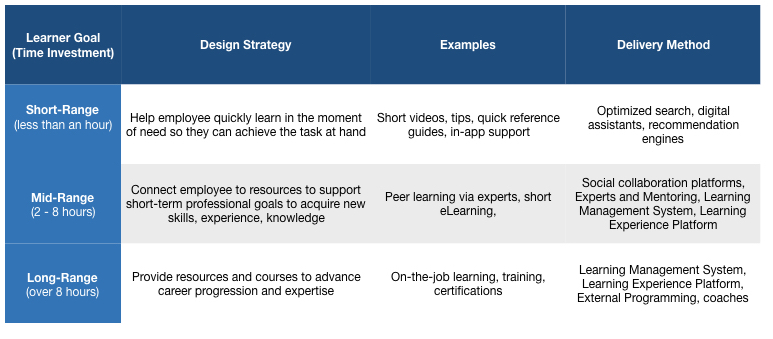As Learning and Development professionals, our goal is to help employees achieve higher levels of performance in order to drive the business to achieve its goals. For many, this means staying in the comfort zone and following traditional methods for learning and development. This is why so much investment (76 percent) is often made in the 10 percent of where people learn: formal training (instructor-led and/or e-learning).
It’s time to get uncomfortable about how we design and develop our workforce.
The 2020 Coronavirus pandemic has resulted in companies scrambling to quickly transition high-cost traditional training into more virtual formats. With in-person training off the table, Learning and Development (L&D) organizations are being forced to flip the paradigm to digitally deliver educational programming in order to maintain business continuity. This movement away from tangible, check-the-box training toward more informal, social, and technology-based learning delivery makes people uncomfortable. It’s harder to track, manage, and measure for impact. How long can we continue with the status quo and not challenge ourselves to deliver the next-generation learning experience that is more agile, personalized, and immediate?
Here are a few steps to help you modernize your learning and development practices to improve business continuity through more agile and digital learning methods.
Redefine Client Mindsets
The temptation to quickly respond to training requests is difficult, political, and often unavoidable. With travel restrictions hindering in-person events, L&D has an unprecedented opportunity to help business leaders consider other methods for delivering learning. Now is the time to consult with internal clients and prioritize business problems and redefine mindsets through performance consulting. Question if training is really the answer and help clients understand which business challenges can be solved with learning and provide recommendations for challenges where training is not the ideal solution (e.g., technology, cultural, motivation). Doing so will not only help redefine the mindsets of your clients to minimize requests for “training” and be more open to exploring other methods for increasing knowledge and skills to achieve business and individual performance goals.
Modernize Your Learning Strategy
The new frontier of learning is being able to deliver the right learning, at the right time, to the right person, and for the right reasons. This means moving workforce development investments into more “behind-the-scenes” activities, including content strategies and technology that can deliver more personalized and guided experiences based on employee history, preferences, and goals. Start by redefining your learning strategies to align to what employees need according to three learner goals: short-range, mid-range, and long-range. This simplified matrix provides and examples of how to reverse the learning model in order to focus on less traditional ways to deliver learning.

Simplified Learning Strategy
Define Your Content Strategy
Being able to provide employees with quick access to content (either via search or pushed recommendations) will be a competitive differentiator for businesses. Doing so requires much more discipline and governance than the historical “set it and forget it” mentality that is clogging learning management systems (LMSs), intranets, video libraries, and social collaboration platforms. Employees simply cannot find what they need, and it’s estimated that 60 to 70 percent of content goes unused. When employees can’t find what they need when they need it, they will bypass company resources for the risky realm of the public domain. How can companies improve their internal search and delivery to drive employees to “sanctioned” company content?
While documenting content strategy may seem “unsexy,” it’s one of the most important tasks a business can take to deliver a more personalized and consumer-grade experience to its employees. This means taking a systems approach to content by better tagging to increase search optimization and implementing governance to retire content from the system when it is no longer relevant. Start treating your content like a business asset by leveraging marketing techniquesto help you provide the right content at the right time.
Map Your Technology Ecosystem
Technology should be thought of as the enabler for delivering a better experience for employees, which is why it’s listed last in this article. Leading with technology often leads to redundant systems, misaligned investments, and disjointed employee experiences (seriously, how many virtual delivery platforms does a company need?). One way to limit the distraction of the next shiny object that comes to market is to map your technology ecosystem.
Begin by doing an inventory of the learning technology landscape. Creating a map will allow the learning organization to identify redundancies, gaps, and whitespace. When creating your map, capture technology across the entire learning experience from how they are analyzed as needed (assessments), discovered (recommendations), consumed (LMS), experienced (on-the-job opportunities), connected to others (mentoring, experts, coaches), and created (content development platforms). RedThread research has an excellent framework to assist with building out an ecosystem according to technology functionalities (Plan-Discover-Consume-Experiment-Perform-Connect-Manage and Create-Measure). Once mapped, use the landscape to make more intentional decisions on what technologies are being used to deliver your learning experience.
Wrapping Up
While we are in an unprecedented and unfortunate moment of history, one that will affect us all for years to come, it does give Learning and Development professionals an opportunity to step in and lead the discussion for next-generation workforce development strategies. Helping our clients and employees adopt less traditional methods of gaining knowledge and experience may make them uncomfortable. But doing so will lead to a more agile and resilient workforce in the future.
Kelly Rider is a learning leader and strategist who is energized by the future of learning and how technology will augment the ways in which employees perform their work.




